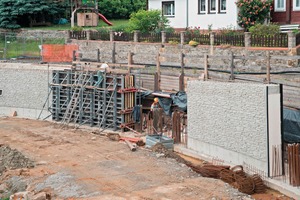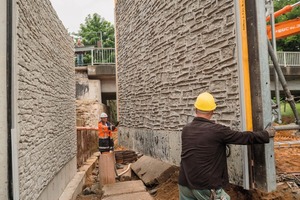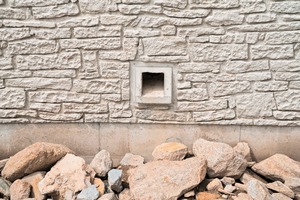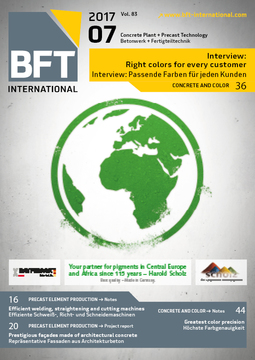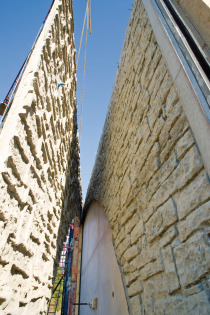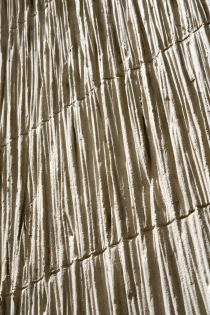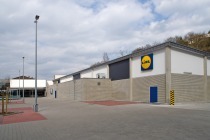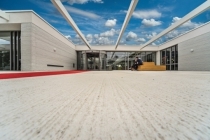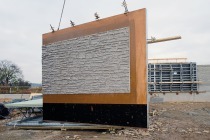Curved, textured, structurally stable
Grossschönau is a town in the district of Görlitz, German State of Saxony, and has a history of flooding. This happened most recently in 2013, when the Mandau, a small river, broke its banks. The huge flow of flood water damaged not only cellars and gardens but also an important retaining wall. Part of the wall could actually be repaired; however, other sections were so severely damaged that they had to be replaced. The new sections were to be constructed in reinforced concrete (C30/37; exposure classes XC4, XD1, XF2, XA2) and should resemble the existing masonry, as specified by the local conservation authority.
Reproducing a
natural stone appearance
This meant that the new retaining wall sections should have the surface relief of a randomly arranged natural stone masonry wall. To achieve this look, the main contractor chose textured formliners manufactured by NOE-Schaltechnik. The manufacturer markets them under the NOEplast brand and has an extensive range of standard designs available. NOEplast textured formliners can give concrete the surface texture of, for example, wooden boards, bush-hammered concrete or even plaster. The Murus Romanus motif was chosen for the retaining wall in Grossschönau. This textured formliner is approximately 4.1 cm thick and comes in a standard size of 6.00 × 2.50 m. It can also be manufactured and supplied to larger dimensions. The formliners have matching sawtooth edges that allow them to be butted together without an obviously visible joint.
Textured surfaces
For forming a textured surface in concrete using NOEplast, the formliner simply needs to be placed in an appropriate form on the vibrating table. For in-situ casting it has to be glued to the formwork. Then the concrete is poured and compacted. As soon as the concrete has achieved adequate strength, the formwork including the formliner can be removed to reveal the selected texture. The special feature of NOEplast standard textured formliners is that they have a glass fiber fabric backing, which ensures they are robust and minimizes dimensional changes due to temperature fluctuations. Moreover, the formliners can be used up to 100 times, which drastically reduces the price per square meter of concrete surface per use cycle.
To the Grossschönau site, NOE supplied only 36 m² of Murus Romanus textured formliners, which were then used up to eight times. NOE-Schaltechnik is ithe only manufacturer that can supply customers with textured formliners already glued in the factory onto formwork or supporting boards that can be screwed to the formwork panels. Bau GmbH Franke preferred to use this service in Grossschönau, where the formliners were not fixed to standard wall panels but to NOE Combi 70 panels.
No tie rod marks in fair-faced concrete: NOE Combi 70
This formwork system is stiffened by 70 cm deep galvanized light truss girders. The girders are spaced at centers of 100 to 150 cm depending on acting loads. This system is highly resilient because the tie rods are positioned 10 cm above the top of the foundation and at a height of just under 3 m, which is usually above the top of the wall. The actual formwork element consists of a grillage of multi-hole channels and vertical NOEtop edge profiles attached to a 21 mm thick basic panel facing. To this can be attached any conceivable kind of formwork liner for producing fair-faced concrete – such as NOEplast textured formliners – and subsequently screwed into place. Because the retaining wall in Grossschönau does not run in a straight line, but to a certain extent follows the course of the river, the curve was idealized as a polygonal chain and the NOE Combi 70 units installed on a series of angled straight lines.
The special feature of the NOE Combi 70 system is that it can be used to construct fair-faced concrete surfaces up to a concreting height of 290 cm, with virtually no tie rod holes or butt joints to be seen on the exposed surface. In addition, the NOE Combi 70 units can be placed one upon the other up to a formwork height of 450 or 600 cm. For construction, the 84 m long wall was divided into 14 segments. Flexible movement joints were installed at approximately 6 m centers with front and back water stops.
Service, formwork,
repeat business
The contractor originally intended to construct the retaining wall with conventional wall formwork. However, this would have had the disadvantage that considerably more tie rod marks would have been visible and the curved wall alignment would not have been as elegant. Instead, the engineers at NOE’s Cottbus subsidiary suggested the adjustable option in their quotation, which is possible only with NOE Combi 70. This solution was then adopted on the job site.
The main contractor placed a new order with the formwork manufacturer very shortly afterwards, which is testimony to the successful completion of this project.

